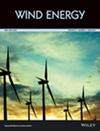Real‐time rotor effective wind speed estimation based on actuator disc theory: Design and full‐scale experimental validation
IF 3.3
3区 工程技术
Q3 ENERGY & FUELS
引用次数: 0
Abstract
{ The use of state estimation techniques offers a means of inferring rotor effective wind speed from standard measurements of wind turbines. Typical wind speed estimators rely upon a pre-computed quasi-steady aerodynamic mapping, which describes the relationship between pitch angle and tip-speed ratio and the power coefficient. In practice, the static mapping does not capture the influence of turbine structural dynamics and atmospheric turbulence, inevitably resulting in poor performance of the wind speed estimation. In addition, the turbine aerodynamic properties might not be easily accessible. Thus, this paper presents a rotor effective wind speed estimation method that obviates the requirement for prior knowledge of turbine power coefficients. Specifically, the proposed method exploits a simple actuator disc model, where the aerodynamic power and thrust coefficients can be characterised in terms of axial induction factors. Based on this insight and standard turbine measurements, real-time estimation of rotor effective wind speed and axial induction factors can then be achieved using a simplified turbine基于传动盘理论的实时转子有效风速估计:设计和全尺寸实验验证
{状态估计技术的使用提供了一种从风力涡轮机的标准测量推断转子有效风速的方法。典型的风速估计依赖于预先计算的准稳态气动映射,该映射描述了俯仰角、叶尖速比和功率系数之间的关系。在实际应用中,静态映射没有捕捉到涡轮结构动力学和大气湍流的影响,不可避免地导致风速估计的性能较差。此外,涡轮的空气动力学特性可能不容易获得。因此,本文提出了一种转子有效风速估计方法,该方法消除了对涡轮功率系数先验知识的要求。具体来说,所提出的方法利用了一个简单的驱动器盘模型,其中气动功率和推力系数可以用轴向感应系数来表征。基于这种见解和标准涡轮测量,可以使用简化的涡轮实现转子有效风速和轴向感应系数的实时估计
本文章由计算机程序翻译,如有差异,请以英文原文为准。
求助全文
约1分钟内获得全文
求助全文
来源期刊

Wind Energy
工程技术-工程:机械
CiteScore
9.60
自引率
7.30%
发文量
0
审稿时长
6 months
期刊介绍:
Wind Energy offers a major forum for the reporting of advances in this rapidly developing technology with the goal of realising the world-wide potential to harness clean energy from land-based and offshore wind. The journal aims to reach all those with an interest in this field from academic research, industrial development through to applications, including individual wind turbines and components, wind farms and integration of wind power plants. Contributions across the spectrum of scientific and engineering disciplines concerned with the advancement of wind power capture, conversion, integration and utilisation technologies are essential features of the journal.
 求助内容:
求助内容: 应助结果提醒方式:
应助结果提醒方式:


